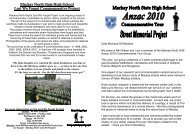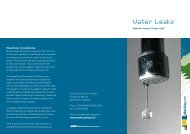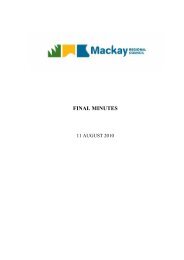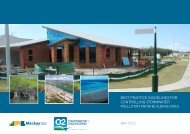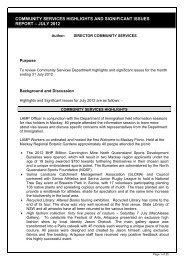Emergency Action Guide - Mackay Regional Council
Emergency Action Guide - Mackay Regional Council
Emergency Action Guide - Mackay Regional Council
Create successful ePaper yourself
Turn your PDF publications into a flip-book with our unique Google optimized e-Paper software.
CYCLONE PREPARATION CHECKLIST<br />
(Information prepared by <strong>Emergency</strong> Management Queensland)<br />
before the cyclone season<br />
> Check with your local council to see if your home has been built to cyclone standards<br />
> Check Insurance companies to insure against “Rising Sea water” - it may be possible<br />
> Check that the walls, roof and eaves of your home are secure<br />
> Trim treetops and branches well clear of your home<br />
> Preferably fit shutters, or at least metal screens to all glass areas<br />
> Clear your property of loose material that could blow about and possibly<br />
cause injury or damage<br />
> In case of storm surge/tide warning, plan your nearest safe location on high ground<br />
and the safest route to it (<strong>Mackay</strong> does not have Certified Shelters)<br />
> Have a Cyclone <strong>Emergency</strong> Kit on hand<br />
> Check on neighbours, especially recent arrivals, to make sure they are prepared.<br />
when a cyclone watch is issued<br />
> Re-check your property for any loose material<br />
> Fill vehicles’ fuel tanks. Check Cyclone <strong>Emergency</strong> Kit and fill water containers<br />
> Ensure household members know which is the strongest part of the house<br />
> Tune to your local radio/TV for further information or warnings<br />
> Check that neighbours are aware of the situation and are preparing.<br />
4<br />
prepare an emergency kit<br />
Every family should have a fully stocked <strong>Emergency</strong> Kit stored safely in their home. Record your next of kin telephone<br />
number on your mobile phone under “ICE” (In Case of <strong>Emergency</strong>). Check your kit every three months to stock up and<br />
rotate supplies to ensure provisions are not out of date and safe to use.<br />
<strong>Emergency</strong> Kit checklist:<br />
Battery-operated radio (with spare batteries)<br />
Torch (spare batteries)<br />
Candles, lighter and waterproof matches<br />
First Aid Kit<br />
Combination pocket knife<br />
Portable stove with fuel<br />
Cooking utensils<br />
Water in sealed containers (30L per person)<br />
Medications<br />
Toiletry and sanitary supplies<br />
Change of clothes and strong shoes<br />
Canned food – enough for 3-4 days (can opener)<br />
Special needs for infants, the aged and<br />
people with disabilities<br />
Pet food, water and other animal needs<br />
Tent or tarpaulin and blankets<br />
Money<br />
Personal Documents - insurance, certificates,<br />
photographs, prescription repeats etc.<br />
Strong plastic bags<br />
<strong>Emergency</strong> phone numbers<br />
Insect repellant and sunscreen<br />
Cordless phones require electricity to operate.<br />
Retain a line phone to reconnect if power is lost.<br />
Your First Aid Kit should have:<br />
- 1 packet of plastic strips - 1 stainless steel scissors<br />
- 1 roll of non-allergic tape - 2 square gauze swabs<br />
- 2 sterile eye pads - 1 bottle antiseptic cream<br />
- 4 triangular bandages - 1 wound closure steri-strip<br />
- 1 conforming gauze bandage - 1 bottle antiseptic solution<br />
- 1 sterile combine dressing - 5 alcohol swabs<br />
- 15 safety pins in a bag - 2 pair of disposable gloves




